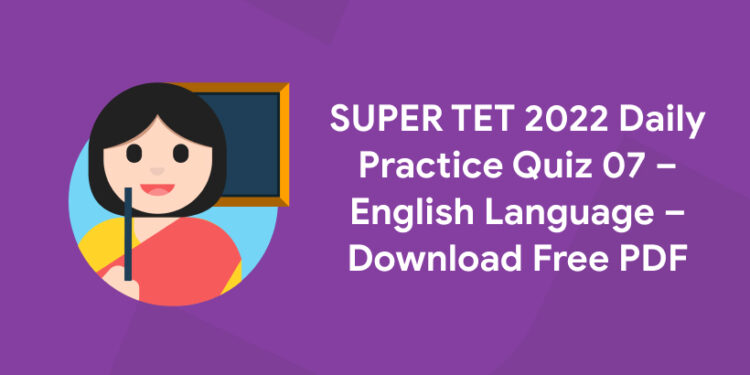The SUPER TET (Super Teacher Eligibility Test) is a national exam to determine your eligibility as a teacher. Government of Uttar Pradesh has issued SUPER TET (Super Teacher Qualification Examination) 2022 for UP supported Middle School Teacher Exam which has a large number of vacancies in UP government. school.
Entri has launched another constructive product for TEACHING aspirants, the SUPER TET Daily Rank Booster, to help you stay one step ahead of your success, quality-based questions, hone your skills and improve your performance in every way imaginable.
Join our Telegram channel for latest updates on SUPER TET Exam 2022
SUPER TET 2022 Daily Practice Quiz 07 – English Language
1. In syntax, the interest is focused on the
(a) Vocabulary
(b) Arrangement of words
(c) Grammar
(d) Sounds
Ans: Arrangement of words
Solution: Grammar is the study and practice of the rules by which words change their forms and are combined into effective and meaningful sentences. It is referred to the total mechanism of the language which enables its users to communicate with each other. It includes the various components of a language that are syntax, morphology, and phonetics. Syntax: It studies how a sentence is being structured and lays emphasis on the arrangement of words to form a meaningful text.
2. Arti Saxena, an English teacher of class VV, always tries that her learners should pronounce the word correctly and spell it correctly. Which aspect of vocabulary development does she try to develop in her learners?
(a) Semantic
(b) Phonetic
(c) Phonetic cum graphic
(d) Graphic
Ans: Phonetic
Solution: Vocabulary plays a major role in meaningful verbal communication. It is a tool through which communication in any language is possible. Acquiring the vocabulary of a vernacular language is easy for the learners, whereas it is very difficult in the case of learners of a second language, especially, English, as a second language. Various aspects of vocabulary development are: Phonetics deals with the correct pronunciation and spelling of words used in a language. Semantic: It is the study of the meaning of lexical words. Semantics make communication possible by giving meaning to certain symbols and words. Graphic, in terms of vocabulary, refers to the use of writing skills for learning vocabulary. Phonetic cum graphic is the use of both pronunciation and writing skills. Hence, we conclude that the above statement is about the phonetic aspect of learning vocabulary.
3. We use real objects to teach young learners new words because
(a) it helps learners associate words with objects they see in real life
(b) it helps in teaching the correct spelling of words
(c) we can teach vocabulary only through real objects
(d) young learners are not capable of abstract thinking
Ans: it helps learners associate words with objects they see in real life
Solution: The use of real objects to teach young learners can make the learning experience more significant and make the link between objects and vocabulary words or other language concepts. This can make it easier to remember information. It strengthens students’ associations between words for everyday objects and the objects themselves. For example, if the teacher is going to teach the vocabulary of fruit and vegetables it can be much more effective for students if they can touch, smell and see the objects at the same time as hearing the new word. This would appeal to a wider range of learner styles. It strengthens the language skills and attracts both visual and kinesthetic learners of all ages. From the above, it is clear that we use real objects to teach young learners new words because it helps learners associate words with objects they see in real life.
4. In learning of English as a second language committing an error is:
(a) a problem that needs to be rectified immediately.
(b) an indicator of learning.
(c) a hindrance that hampers learning.
(d) a problem.
Ans: an indicator of learning.
Solution: In learning English as a second language committing an error is an indicator of learning. Error is a grammatically incorrect form and is a sure indication that the learner has not mastered the code of the second language. At this point, we will not go into the reason why such errors occur (we shall discuss this question in later sections).
5. A test which evaluates a person’s ability to communicate well in real life:
(a) Placement test
(b) Diagnostic test
(c) Proficiency test
(d) Achievement test
Ans: Proficiency test
Solution: Evaluation: It refers to a continuous process of making value judgments based on both qualitative and quantitative data collected over a while. It is closely related to learning objectives since it tells if the student is good or poor in performance. Various tests are used to assess a child and then evaluate him: Proficiency test: It is a type of language test which measures the ability of a person to listen, speak, read and write. It evaluates how well an individual can use language to communicate in daily life. Placement test: It determines the academic skill levels of entering students to place them in the right class. Diagnostic test: It is administered at the end of the language course to know the gaps in learner’s understanding and then fill the gap by remedial teaching. Achievement test: It is designed to measure skill and knowledge obtained at a grade level to determine the level of instructions for which a student is prepared. Hence, we conclude that the above statement is of the proficiency test.
6. Cummins \& Swains, in their book Bilingualism in Education, differentiates between ——— and ——–.
(a) BICS & CALP
(b) Preparation and Presentation
(c) Practice and Evaluation
(d) All of the above
Ans: BICS & CALP
Solution: BICS (Basic Interpersonal Communicative Skills): The language ability that is associated with BICS largely involves the skills to perform effectively in situations that are rich in context and undemanding at the level of cognition. The language of here and now and that of peer group social interaction belongs to the domain of BICS. Its characteristics are: It is at the top layer of Cummin’s Iceberg’s model. It is the day-to-day language needed to interact socially with other people. It is acquired in 2−32−3 It is native speakers fluency (for example, a Bengali is fluent in Bengali). CALP (Cognitive and Academic Language Proficiency): CALP refers to language use in academic spheres and includes abstract thinking. Its characteristics are: It requires 4−74−7 I includes skills like inferring, classifying, synthesizing, and evaluating. It requires help from an agent to master it. Its examples are Letter Writing, Report Writing.
7. Answer the following question by selecting the correct option.
The full form of CALL is
(a) Cognitive Achievers’ Language Lab
(b) Computer-Assisted Language Learning
(c) Comprehensive Achievers’ Language Lerning
(d) None of the above
Ans: Computer-Assisted Language Learning
Solution: CALL (Computer Assisted Language Learning) “Computer-assisted Language Learning” or “CALL” is a term used to describe any kind of language learning activity that makes use of computers. CALL is a new field that effectively helps in imparting second language learning.
8. Which language ability would you be testing if you asked students to write a few sentences about their family?
(a) Grammar
(b) Vocabulary
(c) Writing
(d) All of these
Ans: All of these
Solution: Ways of Development of writing: The development of writing will build on the foundations provided by the language skills- listening, speaking, and reading. Also, children will learn to write effectively when the act of writing is meaningful, when it is relevant to children’s context and when it is enjoyable for them. These are some of the activities which help a student to develop writing skills. Picture composition: This involves presenting children with a picture (of objects, single events, multiple events), and asking them to write about it. This writing can include a wide variety of compositions. They may be asked to write a story, to describe the picture, to write a dialogue between the characters, to fill in a missing gap in the picture and write about it, etc. When a series of pictures depicting a story is provided, they can be asked to write the story. Developing stories from given outlines: Children can be given a rough outline of a story in the form of a series of words and phrases, and then asked to build a story using these words and phrases. Independent writing: Children can be asked to write about something that they evidently show great interest in or something that they talk about a lot. This will not only help to develop writing skills but may point the teacher towards more techniques for facilitating learning. Continuing the story: Children can be told the beginning of a story and can be asked to write what they think happened next. Dictation: The teacher can speak aloud some words and ask the children to write them to see if they can link the spoken sounds to their written forms. Here the conclusion is that if a student is writing few sentences about their family, we are testing all of the above skills of students.
9. The method of teaching in which the teacher tries to establish a link between the foreign language word and the object without the interference of the learner’s mother tongue is called
(a) the direct method
(b) the bilingual method
(c) the structural method
(d) the grammar-translation method
Ans: the direct method
Solution: Direct Method: This method came into practice as a solution to the problems confronted by the teachers who used the Grammar Translation Method in their classrooms. As the name suggests, this is a method of teaching English directly through English. It stresses the need for a direct association between experience and expression in the foreign language. The Direct Method implies, makes use of a direct link between the words and objects of the Target Language, thus refusing the native language or the mother tongue to act as a mediation. It enhances the conversations between the teachers and the learners to develop in the Target Language. By including well-controlled grammar-based activities and by making the approach more inductive in nature, the method can be modified so as to meet the functional needs of the learners.
10. In order to drive home the point that listening skills matter, students should be
(a) exposed to popular English films and reviewing them
(b) taken to the language lab once a week for practice and feedback
(c) allowed to listen to CD’s of poetry read aloud by well-known voice-artistes
(d) reminded that listening-skill practices relate to real life
Ans: reminded that listening-skill practices relate to real life
Solution: Listening is the process of receiving messages from oral, verbal, and non-verbal communication and interpreting the same. The aim of teaching a language is to prepare the learner for life. Listening, being a significant part of the business of daily living, needs to be practiced extensively. Learners need to be prepared to handle situations in life even beyond the classroom and after leaving school where they might need to obtain information from radio or television talks and chats, videos on various themes, announcements, telephonic information, directions, or simply, as oral information from another person.
SUPER TET Daily Practice Quiz 2022 Download Free PDF












